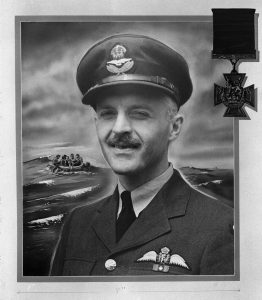Flight Lieutenant David Hornell, VC
David Ernest Hornell was born in Toronto, Ontario on 26 January 1910. In 1941 he enlisted in the Royal Canadian Air Force (RCAF), qualified as a pilot and was commissioned in 1942. At the time of the action for which he received the Victoria Cross posthumously, Flight Lieutenant Hornell was flying as aircraft captain on Consolidated Canso amphibians with No. 162 (Bomber Reconnaissance) Squadron, RCAF from Royal Air Force (RAF) Station Wick in Northern Scotland.
Late in the day on 24 June 1944, Hornell’s Canso was at the end of a 12-hour patrol over the North Atlantic when the German submarine U-1225 was sighted on the surface approximately 120 miles north of the Shetland Islands. As the aircraft made its attack run, heavy and accurate anti-aircraft fire from the U-boat crippled the starboard engine and started a fire on the starboard wing. With great determination and skill, Hornell held the vibrating Canso on course and delivered his four depth charges on target, sinking the submarine. Shortly thereafter the starboard engine fell out of the wing, forcing Flight Lieutenant Hornell to ditch the aircraft, by now a flaming wreck, in the heavy seas. With only one dinghy serviceable, for several hours the eight members of the crew had to take turns holding on to the life-raft’s side while immersed in the icy water. Although the dinghy was spotted by a Consolidated Catalina flying boat from No. 333 (Norwegian) Squadron, RAF five hours after Hornell had ditched, for the next 16 hours rescue attempts were frustrated by high seas and malfunctioning equipment. Two of the crew eventually died of exposure. At one point, Flight Lieutenant Hornell had to be restrained by his comrades when, though at the end of his own strength and about to go blind, he proposed to swim to an airborne lifeboat that had been dropped. Finally, after 21 hours, a rescue launch arrived to pick up the survivors, but all attempts to revive Hornell failed, and he died of exposure.
Flight Lieutenant Hornell was the first member of the RCAF to be awarded the Victoria Cross.
Citation
“Flight Lieutenant Hornell was captain and first pilot of a twin-engined amphibian aircraft engaged on an anti-submarine patrol in northern waters. The patrol had lasted for some hours when a fully-surfaced U-boat was sighted, travelling at high speed on the port beam. Flight Lieutenant Hornell at once turned to the attack.
The U-boat altered course. The aircraft had been seen and there could be no surprise. The U-boat opened up with anti-aircraft fire which became increasingly fierce and accurate.
At a range of 1,200 yards, the front guns of the aircraft replied; then its starboard guns jammed, leaving only one gun effective. Hits were obtained on and around the conning-tower of the U-boat, but the aircraft was itself hit, two large holes appearing in the starboard wing.
Ignoring the enemy’s fire, Flight Lieutenant Hornell carefully manoeuvred for the attack. Oil was pouring from his starboard engine, which was, by this time, on fire, as was the starboard wing; and the petrol tanks were endangered. Meanwhile, the aircraft was hit again and again by the U-boat’s guns. Holed in many places, it was vibrating violently and very difficult to control.
Nevertheless, the captain decided to press home his attack, knowing that with every moment the chances of escape for him and his gallant crew would grow more slender. He brought his aircraft down very low and released his depth charges in a perfect straddle. The bows of the U-boat were lifted out of the water; it sank and the crew were seen in the sea.
Flight Lieutenant Hornell contrived, by superhuman efforts at the controls, to gain a little height. The fire in the starboard wing had grown more intense and the vibration had increased. Then the burning engine fell off. The plight of aircraft and crew was now desperate. With the utmost coolness, the captain took his aircraft into wind and, despite the manifold dangers, brought it safely down on the heavy swell. Badly damaged and blazing furiously, the aircraft rapidly settled.
After ordeal by fire came ordeal by water. There was only one serviceable dinghy and this could not hold all the crew. So they took turns in the water, holding on to the sides. Once, the dinghy capsized in the rough seas and was righted only with great difficulty. Two of the crew succumbed from exposure.
An airborne lifeboat was dropped to them but fell some 500 yards down wind. The men struggled vainly to reach it and Flight Lieutenant Hornell, who throughout had encouraged them by his cheerfulness and inspiring leadership, proposed to swim to it, through he was nearly exhausted. He was with difficulty restrained. The survivors were finally rescued after they had been in the water for 21 hours. By this time Flight Lieutenant Hornell was blinded and completely exhausted. He died shortly after being picked up.
Flight Lieutenant Hornell had completed 60 operational missions, involving 600 hours’ flying. He well knew the danger and difficulties attending attacks on submarines. By pressing home a skilful and successful attack against fierce opposition, with his aircraft in a precarious condition, and by fortifying and encouraging his comrades in the subsequent ordeal, this officer displayed valour and devotion to duty of the highest order.”
(London Gazette, no.36630, 28 July 1944)
